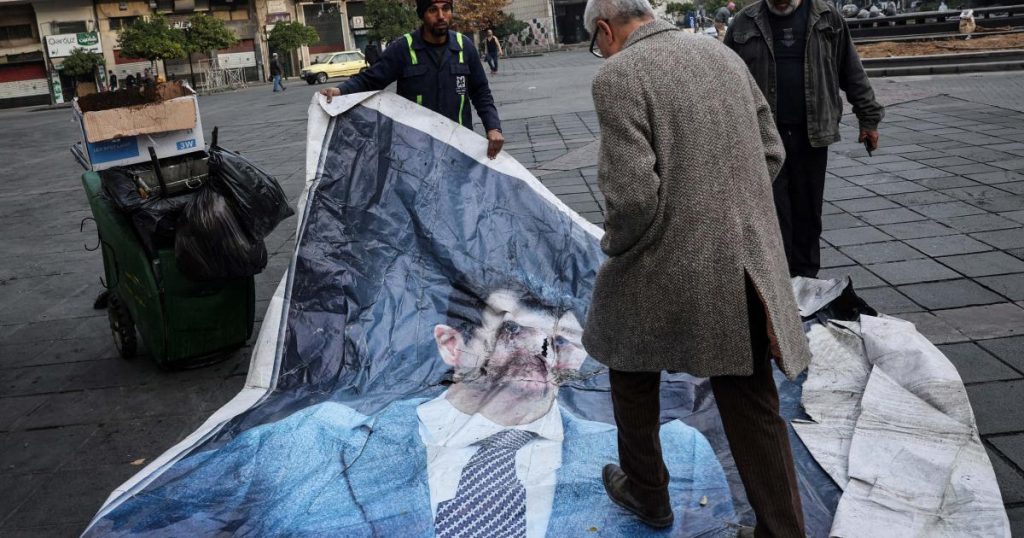
The toppling of Bashar al-Assad in Syria shattered the illusion that stability in the Middle East can be sustained through brute force. The Syrian regime was one of the most brutal in the world. Its atrocities, long known or suspected but hidden from view, have been laid bare: the prisoners routinely tortured and killed, the detainees exposed to sunlight for just ten minutes each year, the children born in jail cells who have never seen a bird or a tree. Yet its terrible repression could not guarantee the regime indefinite control. Iran and Russia, its biggest supporters, could not save it. Most important, the Syrian army, poorly fed and paid, did not have the will to defend it. When militants led by the rebel group Hayat Tahrir al-Sham reached Damascus last December, the capital fell without a fight.
The regime’s collapse should also dispel at last the persistent myth that the Arab Spring was a mirage. The first wave of uprisings, which lasted from 2010 to 2012 and saw hundreds of thousands of people take to the streets to protest autocratic governance across the Arab world, ended, in most cases, with governments tightening their authority. Yet as I argued in 2018 in Foreign Affairs, as long as Arab governments do not properly address the challenges facing the region, popular resistance to their rule will not end. Protest and rebellion will continue. Unless they embrace genuine reform, the region’s leaders will learn the hard way, as Assad did, that no measure of repression can secure their rule over increasingly dissatisfied publics.
But Syria’s new leaders must heed this lesson, too. If they replace Assad’s autocratic regime with one that is also exclusionary and repressive, they will be just as vulnerable to overthrow as he was. But if they are wise enough to pursue a more democratic course, Syria’s political transition could become a turning point for a region where popular demands for responsive governance have been ignored for far too long.
STUCK IN DYSFUNCTION
Today, much of the Arab world is in disarray. Even countries in the Gulf, long considered a bastion of stability, are facing internal challenges. Saudi Arabia and, to a lesser extent, the United Arab Emirates for decades dished out generous aid to neighboring countries. But now, Saudi Arabia seems largely focused on shoring up its domestic economy, and its traditionally staunch support of the Palestinian cause might give way to an effort to normalize relations with Israel. Riyadh weathered the first wave of the Arab uprisings by pouring money on the problem, announcing a social welfare package of more than $130 billion that included pay raises for government employees, new jobs, and loan forgiveness initiatives. Crown Prince Mohammed bin Salman is hoping that, by introducing serious social and economic reforms, Saudi Arabia can resist pressure to reform its politics. So far, his gambit appears to be working; a young generation of Saudis, fed up with the country’s outdated social restrictions, appreciate new measures to lift the ban on women driving, curb the power of the religious police, and allow men and women to mix in public. But tackling the country’s economic problems, such as a youth unemployment rate above 16 percent, will not be so easy.
The challenges faced by the Gulf countries pale in comparison to those confronting the rest of the region. Countries such as Egypt, Jordan, and Tunisia remain unable to reduce their overdependence on foreign aid and remittances, which suppresses productive activity. Others, including Lebanon, Libya, Sudan, and Yemen, have become failed states. Now that Hezbollah is weakened and the influence of its patron, Iran, has waned, Lebanon may be able to break its political impasse, but only if it can loosen the kleptocratic hold of members of the elite. The rest are stuck in seemingly inescapable cycles of dysfunction, corruption, civil strife, and economic decline.
All these countries have one thing in common: continual resistance to opening up their political systems and including a wider array of voices in official decision-making. Poor governance and economic stewardship have impeded the region’s development and generated the grievances behind the Arab Spring. The revolts that swept across the region between 2010 and 2012 challenged the outdated governance models that restrict decision-making to a very small circle of individuals and lack significant checks and balances. A few leaders did fall, but ultimately, authoritarianism prevailed. As fears grew that Islamist groups would take advantage of the disruption and claim power, many protesters returned home without their governments addressing the problems that had driven them to the street. Arab regimes, by deploying the security services and dispensing financial handouts, made possible with oil money, managed not just to survive the unrest but also to brand the protests as either the products of foreign conspiracies or the outbursts of misguided publics that did not know their own best interests. Authoritarian apologists characterized the violence and repression that followed the early demonstrations as an “Arab winter,” casting the initial period of resistance as an aberration.
The discontent that drove the Arab Spring never went away.
For a few years, many Arab states maintained the appearance of stability. But below the surface, people remained resentful and aggrieved. In 2019, major protests broke out in Algeria, Iraq, Lebanon, and Sudan. Rulers quickly quelled this second protest wave with harsh crackdowns. Once again, they claimed victory over the forces of disruption without attempting to address their countries’ underlying economic and political troubles.
Syria is but the latest in a string of reminders that the discontent that drove the Arab Spring never went away. If governments do not give proper attention to domestic problems or show their citizens respect, no amount of external support or internal brutality can sustain a dysfunctional system indefinitely. Many Arab leaders continue to claim they are responding to the wishes of their citizens, but they have not undertaken serious steps to open up their political and economic systems. In Tunisia and Egypt, where revolutions in 2010 and 2011 unseated long-serving dictators, new authoritarian rulers have let economic problems fester, leaving both countries in worse economic shape today than before 2010.
Real reform means creating an environment where citizens can participate in the country’s decision-making process, where respect for ethnic and religious diversity and gender equality are the norm rather than the exception, and where economic opportunity is available based on merit rather than patronage. Otherwise, citizens will continue to feel unfairly treated, and waves of protest and revolt will continue to come. What happened in Syria can happen to any regime that falsely believes it can sustain its power by force alone.
DOOR NUMBER TWO
Assad’s fall should not just be a warning to the rest of the Arab world. It should also be a warning to those who took his place in Syria. Getting rid of a brutal dictator is only half the battle; the Islamists who led the fight to oust the old regime have to decide, now that they are in charge, whether they will follow the same playbook that made Assad vulnerable or adopt a different course.
The most disastrous course that Syria’s new rulers could take would be to govern in the style of the jihadi Islamic State (also known as ISIS), which ruled parts of Iraq and Syria from 2014 to 2017. That outcome seems unlikely: Ahmed al-Shara, the Hayat Tahrir al-Sham leader who has become Syria’s president, was once a jihadi, but he claims to have foresworn extremism. A more likely and thus more troubling prospect exists, however: Shara could follow the path that Islamists took when they came to power in Egypt after the fall of Hosni Mubarak in 2011. The government of Mohamed Morsi, a former leader of the Muslim Brotherhood, was democratically elected. But once in office, he pushed through a constitution that did not meet the demands of all components of Egyptian society. Little more than a year into its rule, the Islamist-led government was toppled by the military in a coup supported by millions of Egyptians—many of them the same people who had taken to the streets to protest the secular tyrant Mubarak in 2011. Tragically, their hopes for a better Egypt were dashed twice: first by Morsi’s abuses and overreach and then by the return of secular authoritarianism under Abdel Fattah el-Sisi, the general who took power in 2013 and proceeded to establish a regime arguably even more repressive than the one Mubarak led.
The failure of the Egyptian experiment had ripple effects across the region. Leaders elsewhere pointed to the years of instability and repression that followed the uprising in Egypt as a warning to their own citizens. Arab publics, they argued, should accept secular authoritarian governments, with all their shortcomings, rather than take a risk on an Islamist system that would bring social restrictions and economic uncertainty. If Syria’s new rulers adopt exclusionary policies that ignore the cultural, religious, and gender diversity of its citizens, they are bound to fail—just as Morsi did in Egypt. Their collapse, and whatever misery may follow, would reinforce the argument that revolutions are futile, stifling the forces in the region that for more than a decade have been pushing for change.
Rulers ignore the demands of the people at their own peril.
But there is another route the Syrian government can take, and it, too, could lead to transformation throughout the region. The country’s new leaders could learn from the mistakes of their Islamist forebears and avoid a system of government with slim chances of success. They know that exclusionary rule will invite internal resistance from constituents such as the Free Syrian Army, composed of a wide variety of rebel factions; the Kurds, who control large parts of eastern Syria; and the country’s many other minority groups. They also know that insisting on an exclusionary Islamic system would antagonize important neighbors, such as Jordan and Saudi Arabia. Shara has indicated that he plans to rule in a way that includes Kurds, Christians, and other minorities—a notable break with the policies promoted by al Qaeda, of which Shara was a member until 2016. But rhetoric alone will not suffice. The regime must show it means to follow through. Starting with the replacement of the interim cabinet that has served since December, and continuing with the drafting of a new constitution and with elections to form a government with a popular base of support, Syria’s new rulers must take clear steps toward governance under civil law and representation of all segments of Syrian society, including women, Alawites, Christians, Druze, and Kurds.
It may be unrealistic to expect such inclusion. Shara and his troops are not known for their democratic tendencies, nor do they have experience in governing a country in dire economic straits. If foreign countries shy away from working with the new government, they could end up steering it toward radicalism. Some neighboring countries may more intentionally seek to thwart the emergence of a pluralist Syria, too, lest Syria’s success create pressure to reform their own political processes.
But that pressure is precisely what the region needs. And the new leadership in Damascus has the tools to build the kind of durable system that would exert such pressure, should it choose to use them. Syrians inside and outside the country have vast political and economic experience, and if called upon, they can help make the transition to a functional, prosperous democracy. The international community can provide essential financial and political support, conditioning their assistance on concrete steps toward inclusivity. Potential obstacles have diminished, too. Iran’s failure to shield Hamas in Gaza, Hezbollah in Lebanon, and Assad in Syria dealt a dramatic blow to Tehran’s standing in the region. Iranian and Russian support kept the former Syrian regime alive for the past decade, and these countries’ loss of influence—along with Hezbollah’s humbling—has removed a significant barrier to pursuing pluralism and the rule of law.
BREAKING THE CYCLE
There is no guarantee that Syria’s new rulers will take advantage of the current opening. They must recognize that the brutal authoritarian model of the regime they replaced was ultimately unsustainable, as is any political system based on exclusion and iron-fisted rule. If they heed the warnings of past failures and choose the pluralistic route, they can chart a path to a better future for Syria and help stabilize a fragile region, generating economic opportunity, facilitating the return of millions of Syrian refugees, and putting considerable pressure on other Arab governments to embark on serious reform.
If they fall back on repression, they will subject Syria to a grim fate. They could set back the cause of democracy across the region, too, giving ammunition to factions that claim the Arab uprisings only end in defeat. Yet even if protests have so far not ushered in durable political transformation, every wave of demonstrations has sharpened Arab populations’ awareness of the need for institutional reform. Success in Syria has the potential to finally break the cycle of protest and repression and set the region on a more pluralistic and prosperous course. A return to authoritarianism will only delay the inevitable lesson that all Arab leaders should have learned after 2010 and that Syria’s in particular should have learned when they brought down Assad—that rulers ignore the demands of the people at their own peril.
Loading…








